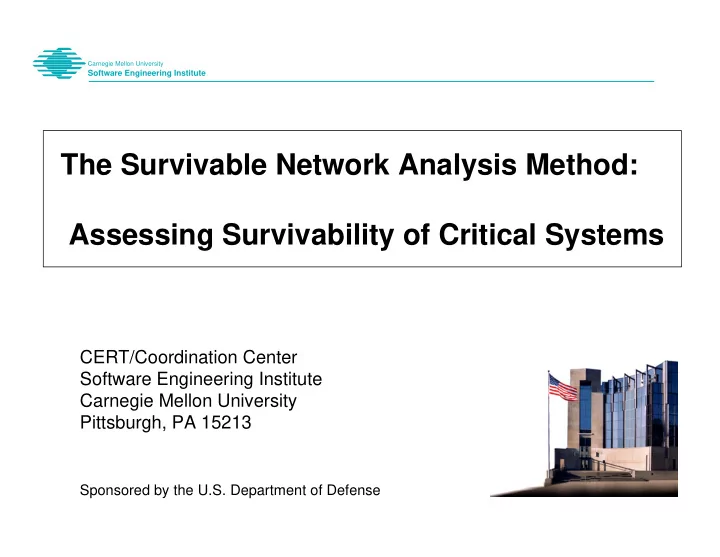

Carnegie Mellon University Software Engineering Institute The Survivable Network Analysis Method: Assessing Survivability of Critical Systems CERT/Coordination Center Software Engineering Institute Carnegie Mellon University Pittsburgh, PA 15213 Sponsored by the U.S. Department of Defense 1
Carnegie Mellon University Software Engineering Institute Mission Survivability 2
Carnegie Mellon University Software Engineering Institute Changing Environment • System Evolution – expanding network boundaries – additional participants with varying levels of trust – numerous point solutions: Public Key Infrastructure, Virtual Private Networks, Firewalls – blurring of Intranet and Extranet boundaries – new technologies -- directory services, XML • The impact of attacks is on organizations, and hence on the applications which support the organization’s mission 3
Carnegie Mellon University Software Engineering Institute Impact on Analysis • Lack of complete information – physical and logical perimeters – participants, untrusted insiders – software components --- COTS Java, etc. • Mix of central and local administrative control • Critical components more exposed • An attack could impact essential business services 4
Carnegie Mellon University Software Engineering Institute Survivability Defined Survivability is the ability of a system to fulfill its mission, in a timely manner, in the presence of attacks, failures, or accidents. 5
Carnegie Mellon University Software Engineering Institute Key properties • Mission Focus – Identification of risks and trade-offs – Alternative means to meet mission • Assume imperfect defenses 6
Carnegie Mellon University Software Engineering Institute The “Three Rs” • Resistance – Capability to deter attacks • Recognition – Capability to recognize attacks and extent of damage • Recovery – Capability to provide essential services/assets during attack and recover full services after attack 7
Carnegie Mellon University Software Engineering Institute Techniques and Methods • Traditional Security – fortress model: firewalls, protection, security policy – insider trust – encryption, authentication, passwords – resistance and recognition with recovery secondary • Survivability is enhanced by – security techniques where applicable – redundancy, diversity, general trust validation, etc – automated recovery support 8
Carnegie Mellon University Software Engineering Institute Example • E-mail – E-mail content tunnels through firewalls – Always time lag between initial discovery and upgraded virus signatures required for scans – Enhanced e-mail functionality • Attachments (Word macros) • Rich content such as HTML, Javascript – Resistance and recognition limited. Recovery strategies essential. – Significant impact on services other than e-mail. 9
Carnegie Mellon University Software Engineering Institute The Survivable Network Analysis Method • Focus – early phase of life cycle – applications as well as system infrastructure – tailorable depending on stage of development. • Three options for SNA analysis – survivability architecture – survivability requirements – mission lifecycle 10
Carnegie Mellon University Software Engineering Institute Architectural Focus • Capture assumptions such as boundaries and users • Support system evolution as requirements and technologies change – evolving functional requirements – trend to loosely coupled – requirements for integration across diverse systems • Assist with product selection and integration with respect to rapidly changing security product world 11
Carnegie Mellon University Software Engineering Institute General Method • Identify essential services with normal usage. • Generate intrusion scenarios which are use cases for intruder • Evaluate system in terms of response to scenarios – Requirements: propose response to intrusions – Architecture: evaluate system and operational behavior • Mission impact – applications as well as system components – stakeholders input essential 12
Carnegie Mellon University Software Engineering Institute Survivability Architecture • Make recommendations for survivability improvements • Identify decision and tradeoff points - areas of high risk • Identify trade-offs with other software quality attributes – safety, reliability, performance, usability 13
Carnegie Mellon University Software Engineering Institute The Survivable Network Analysis Method STEP 2 ESSENTIAL CAPABILITY DEFINITION • Essential service/asset selection/scenarios • Essential component identification STEP 4 SURVIVABILITY ANALYSIS STEP 1 • Softspot component (essential & SYSTEM DEFINITION compromisable) identification • Mission requirements definition • Resistance, recognition, and • Architecture definition and elicitation recovery analysis • Survivability Map development STEP 3 COMPROMISABLE CAPABILITY DEF’N • Intrusion selection/scenarios • Compromisable component identification 14
Carnegie Mellon University Software Engineering Institute Determining Survivability Strategies Improved Survivable System Essential Services Requirements/ Network Requirements/ Intrusion Effects Architecture Analysis Architecture Mitigation Strategies SEI CERT/CC Intrusion Knowledge 15
Carnegie Mellon University Software Engineering Institute Survivability Map Intrusion Softspot Architecture Resistance Recognition Recovery Scenario Effects Strategies for � (Scenario Current 1) Recommended … (Scenario Current n) Recommended • Roadmap for management evaluation and action 16
Carnegie Mellon University Software Engineering Institute Option: Survivability Requirements • Identify requirements for mission-critical functionality – minimum essential services – graceful degradation of services – restoration of full services • Identify explicit requirements for – recovery – recognition – resistance 17
Carnegie Mellon University Software Engineering Institute Option: Mission Lifecycle • Factor survivability into the development and operational lifecycle • Capture security and survivability assumptions – boundaries, users • Identify survivability decision points – impact of changes on recovery, intrusion detection, etc. 18
Carnegie Mellon University Software Engineering Institute Benefits of the SNA • Clarified requirements • Documented basis for system decisions • Basis to evaluate changes in architecture • Early problem identification • Increased stakeholder communication 19
Carnegie Mellon University Software Engineering Institute Additional Information • SNA Case Study: The Vigilant Healthcare System – IEEE Software: July/August 1999 • Survivability: Protection Your Critical Systems – IEEE Internet Computing: Nov/December 1999 • Web site: IEEE article and other reports www.sei.cmu.edu/organization/programs/nss/surv-net-tech.html 20
Recommend
More recommend